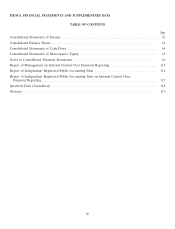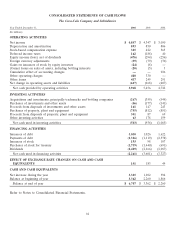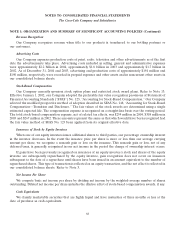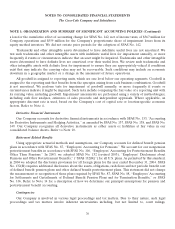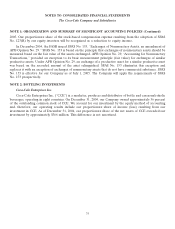Coca Cola 2004 Annual Report Download - page 70
Download and view the complete annual report
Please find page 70 of the 2004 Coca Cola annual report below. You can navigate through the pages in the report by either clicking on the pages listed below, or by using the keyword search tool below to find specific information within the annual report.NOTES TO CONSOLIDATED FINANCIAL STATEMENTS
The Coca-Cola Company and Subsidiaries
NOTE 1: ORGANIZATION AND SUMMARY OF SIGNIFICANT ACCOUNTING POLICIES (Continued)
Revenue Recognition
Our Company recognizes revenue when title to our products is transferred to our bottling partners or
our customers.
Advertising Costs
Our Company expenses production costs of print, radio, television and other advertisements as of the first
date the advertisements take place. Advertising costs included in selling, general and administrative expenses
were approximately $2.2 billion in 2004, approximately $1.8 billion in 2003 and approximately $1.7 billion in
2002. As of December 31, 2004 and 2003, advertising and production costs of approximately $194 million and
$190 million, respectively, were recorded in prepaid expenses and other assets and in noncurrent other assets in
our consolidated balance sheets.
Stock-Based Compensation
Our Company currently sponsors stock option plans and restricted stock award plans. Refer to Note 13.
Effective January 1, 2002, our Company adopted the preferable fair value recognition provisions of Statement of
Financial Accounting Standards (‘‘SFAS’’) No. 123, ‘‘Accounting for Stock-Based Compensation.’’ Our Company
selected the modified prospective method of adoption described in SFAS No. 148, ‘‘Accounting for Stock-Based
Compensation—Transition and Disclosure.’’ The fair values of the stock awards are determined using a single
estimated expected life. The compensation expense is recognized on a straight-line basis over the vesting period.
The total stock-based compensation expense, net of related tax effects, was $254 million in 2004, $308 million in
2003 and $267 million in 2002. These amounts represent the same as that which would have been recognized had
the fair value method of SFAS No. 123 been applied from its original effective date.
Issuances of Stock by Equity Investees
When one of our equity investees issues additional shares to third parties, our percentage ownership interest
in the investee decreases. In the event the issuance price per share is more or less than our average carrying
amount per share, we recognize a noncash gain or loss on the issuance. This noncash gain or loss, net of any
deferred taxes, is generally recognized in our net income in the period the change of ownership interest occurs.
If gains have been previously recognized on issuances of an equity investee’s stock and shares of the equity
investee are subsequently repurchased by the equity investee, gain recognition does not occur on issuances
subsequent to the date of a repurchase until shares have been issued in an amount equivalent to the number of
repurchased shares. This type of transaction is reflected as an equity transaction, and the net effect is reflected in
our consolidated balance sheets. Refer to Note 3.
Net Income Per Share
We compute basic net income per share by dividing net income by the weighted-average number of shares
outstanding. Diluted net income per share includes the dilutive effect of stock-based compensation awards, if any.
Cash Equivalents
We classify marketable securities that are highly liquid and have maturities of three months or less at the
date of purchase as cash equivalents.
68




